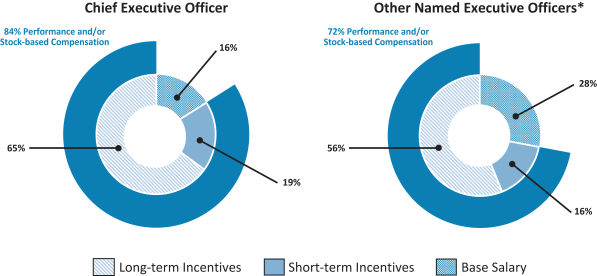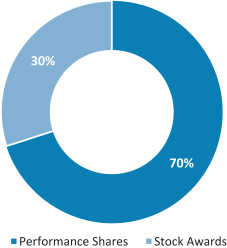SECURITIES AND EXCHANGE COMMISSION
Securities
Exchange Act of 1934
(Amendment No. )
Pursuant to §240.14a-12
|
|
☑ No fee required ☐ Fee paid previously with preliminary materials ☐ Fee computed on table in exhibit required by Item 25(b) per Exchange Act Rules 14a-6(i)(1) and 0-11 Energy for what matters most Welcome to |
|
|
|
|
|
|
|
|
|
|

Always There.®
CenterPoint Energy Inc.
Notice of Annual Shareholder Meeting of Shareholders
to be held on April 26, 2018
and Proxy Statement
|  | |
| ||
![[MISSING IMAGE: ph_philliprsmithsmmeet-4clr.jpg]](/files/DEF 14A/0001104659-24-035036/ph_philliprsmithsmmeet-4clr.jpg)
![[MISSING IMAGE: ph_jasonpwellsmeet-4c.jpg]](/files/DEF 14A/0001104659-24-035036/ph_jasonpwellsmeet-4c.jpg)
![[MISSING IMAGE: bn_banner-4c.jpg]](/files/DEF 14A/0001104659-24-035036/bn_banner-4c.jpg)
2024
We
As explained Details regarding how to attend the meeting and the business to be conducted are in the enclosed proxy statement, at this year’s meeting you will be askedaccompanying Notice of Annual Meeting and Proxy Statement.
| | CenterPoint Energy, Inc. 2024 Proxy Statement | | | | |
YourAnnual Report.
Only shareholders of record at the close of business on March 1, 2018, or their proxy holders,Annual Meeting, we encourage you to vote promptly. You may vote aton the meeting. Attendance at the meeting is limited to shareholdersinternet; by telephone; or their proxy holdersby completing, signing, dating, and CenterPoint Energy guests. Only our shareholders or their valid proxy holders may address the meeting.
Please review thereturning a proxy card for the instructions on how you can vote your shares over the internet, by telephone or by mail. It is important that all CenterPoint Energy shareholders, regardless of the number of shares owned, participate in the affairs of the Company. At CenterPoint Energy’s 2017 Annual Shareholder Meeting, approximately 86 percent of the Company’s outstanding shares were represented in person or by proxy.
voting instruction form.
| | ![[MISSING IMAGE: sg_phillipsmith-bw.jpg]](/files/DEF 14A/0001104659-24-035036/sg_phillipsmith-bw.jpg) | | | ![[MISSING IMAGE: sg_jasonpwells-bw.jpg]](/files/DEF 14A/0001104659-24-035036/sg_jasonpwells-bw.jpg) | |
| | |||||
 |  | ||||
Phillip R. Smith Independent Chair of the Board | | |
Jason P. Wells President, | | |
| | |||||||
| | | | |
![[MISSING IMAGE: bn_banner-4c.jpg]](/files/DEF 14A/0001104659-24-035036/bn_banner-4c.jpg)
| | | | | | 1 | | | |
| ||||||||
| ||||||||
| | | | 6 | | | |||
| | | | 6 | | | ||
| | | | | 21 | | | |
| | | | | 23 | | | ||
| | | | 23 | | | ||
| | | | 24 | | | ||
| | | | 24 | | | ||
| | | | 24 | | | ||
| | | | 25 | | | ||
| | | | 26 | | | ||
| | | | 27 | | | ||
| | | | 27 | | | ||
| | | | 27 | | | ||
| | | | | 29 | | | |
| | | | | 30 | | | ||
| | | | 30 | | | ||
| | | | 31 | | | ||
| | | | 33 | | | ||
| | | | | | 34 | | | |
| | ||||||||
| | | | 36 | | | |||
| | | | 36 | | | ||
| | | | | 38 | | | |
| | | | | 39 | | | ||
| | ||||||||
| | | | 42 | | | |||
| | | | 48 | | | ||
| | | | | 50 | | | ||
| | | | | 52 | | | ||
| | ||||||||
| | | | 56 | | | |||
| | | | 56 | | | ||
| | | ||||||
| | 59 | | |
| |
| | | | 62 | | | ||
| | | | 63 | | | ||
| | | | 64 | | | ||
| | | | 65 | | | ||
| | | | 66 | | | ||
| | | | 67 | | | ||
| | | | 67 | | | ||
| | | | | 73 | | | |
| | | |
| | 76 | | | |||||
| | ||||||||
| | | | 78 | | | |||
| | ||||||||
| | | | 79 | | | |||
| | ||||||||
| | | | 80 | | | |||
| | ||||||||
| | | | 81 | | | |||
| | | | 81 | | | ||
| | ||||||||
| | | | 82 | | | |||
| | ||||||||
| | | | 83 | | | |||
| | | | | | 86 | | | |
| | | | 89 | | | ||
| | | | | 89 | | | |
| | | | | | 91 | | | |
| | | | | 91 | | | ||
| | | | 91 | | | ||
| | ||||||||
| | | | 91 | | | |||
| | | |
| 91 | | | ||||||
| | | | | 91 | | | ||
| | Appendix A | | | | | | | |
| | | | | | A-1 | | |
| | CenterPoint Energy, Inc. 2024 Proxy Statement | | | | |

| ||||
Notice of Annual Meeting of Shareholders | | | ![[MISSING IMAGE: lg_centerpointenergy-4c.jpg]](/files/DEF 14A/0001104659-24-035036/lg_centerpointenergy-4c.jpg) | |
| | ![[MISSING IMAGE: ic_time-pn.gif]](/files/DEF 14A/0001104659-24-035036/ic_time-pn.gif) | | | | ![[MISSING IMAGE: ic_location-pn.gif]](/files/DEF 14A/0001104659-24-035036/ic_location-pn.gif) | | | | ![[MISSING IMAGE: ic_date-pn.gif]](/files/DEF 14A/0001104659-24-035036/ic_date-pn.gif) | |
| | TIME AND DATE 9:00 a.m. Central Time on April 26, 2024 | | | | PLACE The CenterPoint Energy auditorium at 1111 Louisiana, Houston, Texas | | | | RECORD DATE March 1, 2024 | |
| | Items of Business | |
| | • Elect the eleven nominees named in the Proxy Statement as directors to hold office until the 2025 annual meeting; | |
| | • Ratify the appointment of Deloitte & Touche LLP as our independent registered public accounting firm for 2024; | |
| | • Conduct an advisory vote on executive compensation; | |
| | • Vote on a shareholder proposal relating to setting additional interim and long-term Scope 3 emissions goals; and | |
| | • Conduct other business if properly raised. | |
9:00 a.m. Central Time on April 26, 2018.
PLACE
The
ITEMS OF BUSINESS
elect the ten nominees named in the proxy statement as directors to hold office until the 2019 annual meeting;
ratify the appointment of Deloitte & Touche LLP as our independent auditors for 2018;
conduct an advisory vote on executive compensation; and
conduct other business if properly raised.
RECORD DATE
Shareholders of recordcommon stock at the close of business on March 1, 20182024 are entitled to vote.
Sincerely,

Vincent A. Mercaldi
Corporate Secretary
| | Sincerely, | | | ||
| | ![[MISSING IMAGE: sg_vincentamercaldi-bw.jpg]](/files/DEF 14A/0001104659-24-035036/sg_vincentamercaldi-bw.jpg) | | | ||
| | Vincent A. Mercaldi Corporate Secretary | | | Dated and first mailed to shareholders on or about March 15, 2024 | |
| | Important Notice Regarding the Availability of Proxy Materials for the Annual Shareholder Meeting to be Held April 26, 2024 | |
| | The proxy statement and annual report to shareholders are available at: https://materials.proxyvote.com/15189t | |
| | CenterPoint Energy, Inc. 2024 Proxy Statement | | | | |
to shareholders
on or about March 15, 2018
Important Notice Regarding the Availability of Proxy Materials
forVoting Recommendations
vote on the following four proposals. The proxy statement and annual report to shareholders are available at:
http://materials.proxyvote.com/15189T
| | Proposal | | | More Information | | | Board Recommendation | |
| |
|
CENTERPOINT ENERGY, INC.
1111 Louisiana
Houston, Texas 77002
(713)207-1111
For deliveries by U.S. Postal Service:
P.O. Box 4567
Houston, Texas 77210-4567
Proxy Statement
FREQUENTLY ASKED QUESTIONS ABOUT VOTING
On what am I voting?
|
| ||||||||||||
Item 1: Election of directors | | | Page | | | FOR each | |||||||
| | Item 2: Ratification of appointment of the independent accounting firm | | | Page | | | FOR | ||||||
| | Item 3: Advisory vote on executive compensation | | | Page | | | FOR | | |||||
| | Item 4: Shareholder Proposal – Setting additional interim and long-term Scope 3 emissions goals | | Page 86 | | AGAINST | |
Who may vote?
Shareholders recorded
| | CenterPoint Energy, Inc. 2024 Proxy Statement | | | 1 | |
| Name and Primary Occupation | | | Age | | | Director Since | | | Independent | | | Committee Membership | | |||
![[MISSING IMAGE: ph_wendymontoyasm-4c.jpg]](/files/DEF 14A/0001104659-24-035036/ph_wendymontoyasm-4c.jpg) | | | Wendy Montoya Cloonan Houston Managing Partner at Cantu Harden Montoya LLP | | | 44 | | | 2021 | | | ![[MISSING IMAGE: ic_tick-pn.gif]](/files/DEF 14A/0001104659-24-035036/ic_tick-pn.gif) | | | Compensation; Governance, Environmental and Sustainability (Chair) | |
![[MISSING IMAGE: ph_earlmcumminsm-4c.jpg]](/files/DEF 14A/0001104659-24-035036/ph_earlmcumminsm-4c.jpg) | | | Earl M. Cummings Former Independent Chair of Board of CenterPoint Energy, Managing Partner of MCM Houston Properties, LLC, and Chief Executive Officer of The BTS Team | | | 59 | | | 2020 | | | ![[MISSING IMAGE: ic_tick-pn.gif]](/files/DEF 14A/0001104659-24-035036/ic_tick-pn.gif) | | | | |
![[MISSING IMAGE: ph_barbarajduganiersm-4clr.jpg]](/files/DEF 14A/0001104659-24-035036/ph_barbarajduganiersm-4clr.jpg) | | | Barbara J. Duganier Former Managing Director and Global Chief Strategy Officer of the Outsourcing Business at Accenture plc | | | 65 | | | First Time Nominee | | | ![[MISSING IMAGE: ic_tick-pn.gif]](/files/DEF 14A/0001104659-24-035036/ic_tick-pn.gif) | | | | |
![[MISSING IMAGE: ph_christopherhfranksm-4c.jpg]](/files/DEF 14A/0001104659-24-035036/ph_christopherhfranksm-4c.jpg) | | | Christopher H. Franklin Chairman, Chief Executive Officer of Essential Utilities | | | 58 | | | 2022 | | | ![[MISSING IMAGE: ic_tick-pn.gif]](/files/DEF 14A/0001104659-24-035036/ic_tick-pn.gif) | | | Audit; Governance, Environmental and Sustainability | |
![[MISSING IMAGE: ph_raquellewlewissm-4c.jpg]](/files/DEF 14A/0001104659-24-035036/ph_raquellewlewissm-4c.jpg) | | | Raquelle W. Lewis Southeast Texas Director of Communications & Public Information Officer for the Texas Department of Transportation | | | 53 | | | 2021 | | | ![[MISSING IMAGE: ic_tick-pn.gif]](/files/DEF 14A/0001104659-24-035036/ic_tick-pn.gif) | | | Compensation; Governance, Environmental and Sustainability | |
![[MISSING IMAGE: ph_thaddeusjmaliksm-4c.jpg]](/files/DEF 14A/0001104659-24-035036/ph_thaddeusjmaliksm-4c.jpg) | | | Thaddeus J. Malik Principal at S2T Solutions and Attorney | | | 57 | | | Sept. 2023 | | | ![[MISSING IMAGE: ic_tick-pn.gif]](/files/DEF 14A/0001104659-24-035036/ic_tick-pn.gif) | | | Audit; Compensation; Governance, Environmental and Sustainability | |
![[MISSING IMAGE: ph_theodorefpoundsm-4c.jpg]](/files/DEF 14A/0001104659-24-035036/ph_theodorefpoundsm-4c.jpg) | | | Theodore F. Pound Private Investor and Attorney | | | 69 | | | 2015 | | | ![[MISSING IMAGE: ic_tick-pn.gif]](/files/DEF 14A/0001104659-24-035036/ic_tick-pn.gif) | | | Audit; Compensation (Chair) | |
![[MISSING IMAGE: ph_rickyaravensm-4c.jpg]](/files/DEF 14A/0001104659-24-035036/ph_rickyaravensm-4c.jpg) | | | Ricky A. Raven Senior Vice President and Deputy General Counsel at Allstate Insurance Company | | | 63 | | | Sept. 2023 | | | ![[MISSING IMAGE: ic_tick-pn.gif]](/files/DEF 14A/0001104659-24-035036/ic_tick-pn.gif) | | | Compensation; Governance, Environmental and Sustainability | |
![[MISSING IMAGE: ph_philliprsmithsm-4c.jpg]](/files/DEF 14A/0001104659-24-035036/ph_philliprsmithsm-4c.jpg) | | | Phillip R. Smith Independent Chair of the Board of CenterPoint Energy and Chief Financial Officer of Marathon-Sparta Holdings, Inc. | | | 72 | | | 2014 | | | ![[MISSING IMAGE: ic_tick-pn.gif]](/files/DEF 14A/0001104659-24-035036/ic_tick-pn.gif) | | | Audit (Chair); Governance, Environmental and Sustainability | |
![[MISSING IMAGE: ph_barrytsmithersm-4c.jpg]](/files/DEF 14A/0001104659-24-035036/ph_barrytsmithersm-4c.jpg) | | | Barry T. Smitherman President of Barry Smitherman, P.C. and Managing Partner of Smitherman + Associates, L.P. | | | 66 | | | 2020 | | | ![[MISSING IMAGE: ic_tick-pn.gif]](/files/DEF 14A/0001104659-24-035036/ic_tick-pn.gif) | | | Audit; Compensation | |
![[MISSING IMAGE: ph_jasonpwellssm-4c.jpg]](/files/DEF 14A/0001104659-24-035036/ph_jasonpwellssm-4c.jpg) | | | Jason P. Wells President and Chief Executive Officer of CenterPoint Energy | | | 46 | | | Jan. 2024 | | | | | | | |
| | CenterPoint Energy, Inc. 2024 Proxy Statement | | | 2 | |
| | Current / Former CEO of a Public Company Public Company Governance Experience Cybersecurity and Physical Security Risk Management Finance and Accounting | | | Community Involvement Human Capital Management Strategic Planning Utility Industry Experience | | | Government, Legal, and Regulatory Technology and Customer Experience Sustainability Operations and Safety Experience | |
![[MISSING IMAGE: fc_governance-pn.jpg]](/files/DEF 14A/0001104659-24-035036/fc_governance-pn.jpg)
| | CenterPoint Energy, Inc. 2024 Proxy Statement | | | 3 | |
How many votes do I have?
You have one vote for each shareexecutive compensation program. Our executive compensation program is designed to recruit and retain talent, align payment with performance, and align our executive officers’ interests with those of our common stock you owned asshareholders. For more information on our compensation program, see “Compensation Discussion and Analysis” below.
| | Key Features of Our Executive Compensation Program | | | ![[MISSING IMAGE: ic_tick-pn.gif]](/files/DEF 14A/0001104659-24-035036/ic_tick-pn.gif) | | | Strong Pay for Performance | |
| | ![[MISSING IMAGE: ic_tick-pn.gif]](/files/DEF 14A/0001104659-24-035036/ic_tick-pn.gif) | | | No Employment Agreements | | |||
| | ![[MISSING IMAGE: ic_tick-pn.gif]](/files/DEF 14A/0001104659-24-035036/ic_tick-pn.gif) | | | “Double Trigger” Provisions for Change in Control Plan and Equity Awards | | |||
| | ![[MISSING IMAGE: ic_tick-pn.gif]](/files/DEF 14A/0001104659-24-035036/ic_tick-pn.gif) | | | No Excise Tax Gross Up Payments | | |||
| | ![[MISSING IMAGE: ic_tick-pn.gif]](/files/DEF 14A/0001104659-24-035036/ic_tick-pn.gif) | | | Stock Ownership Guidelines | | |||
| | ![[MISSING IMAGE: ic_tick-pn.gif]](/files/DEF 14A/0001104659-24-035036/ic_tick-pn.gif) | | | Benchmark Pay to Market | | |||
| | ![[MISSING IMAGE: ic_tick-pn.gif]](/files/DEF 14A/0001104659-24-035036/ic_tick-pn.gif) | | | Incentive Recoupment Policies | | |||
| | ![[MISSING IMAGE: ic_tick-pn.gif]](/files/DEF 14A/0001104659-24-035036/ic_tick-pn.gif) | | | Anti-Hedging Policy | | |||
| | ![[MISSING IMAGE: ic_tick-pn.gif]](/files/DEF 14A/0001104659-24-035036/ic_tick-pn.gif) | | | 100% Independent Compensation Committee | | |||
| | ![[MISSING IMAGE: ic_tick-pn.gif]](/files/DEF 14A/0001104659-24-035036/ic_tick-pn.gif) | | | Independent Compensation Consultant | | |||
| | ![[MISSING IMAGE: ic_tick-pn.gif]](/files/DEF 14A/0001104659-24-035036/ic_tick-pn.gif) | | | Executive Severance Guidelines | |
| | CenterPoint Energy, Inc. 2024 Proxy Statement | | | 4 | |
How do I vote?
Your vote is important. You may vote in person at the meeting or by proxy. We recommend you vote by proxy even if you plan to attend the meeting. You may always change your vote at the meeting if you are a holder of record or have a proxy from the record holder. Giving us your proxy means that you authorize us to vote your shares at the meeting in the manner you indicated on your proxy card. You may also provide your proxy using the Internet or telephone procedures described on the proxy card.
You may vote for or against each director nominee under Item 1 (election of directors) and the proposals under Item 2 (ratification of appointment of independent auditors) and Item 3 (advisory vote on executive compensation), or you may abstain from voting on these items. If you give us your proxy but do not specify how to vote, we will vote your shares in accordance with the Board’s recommendations.
|
Frequently Asked Questions About Voting (continued)
What are the Board’s recommendations?
The Board’s recommendations are set forth together with the description of each item in this proxy statement. In summary, the Board and, with respect to the ratification of the appointment of the independent auditors, the Audit Committee, recommends a vote as follows:
FOR the election of the ten nominees named in this proxy statement as directors;
FOR the ratification of the appointment of Deloitte & Touche LLP as our independent auditors for 2018; and
FOR the approval, on an advisory basis, of thetarget total direct compensation paidopportunities provided to our named executive officers as disclosed in this proxy statement.
If any other matters properly come before the annual meeting, we will vote the shares in accordance with our best judgment and discretion.
What if I change my mind after I have voted?
You may revoke your proxy before it is voted by:
submittingofficers. As depicted below, a new proxy card with a later date;
voting in person at the meeting; or
giving written notice to Mr. Vincent A. Mercaldi, Corporate Secretary, at CenterPoint Energy’s address shown above.
Will my shares be voted if I do not provide my proxy?
It depends on whether you hold your shares in your own name or in the name of a bank or brokerage firm. If you hold your shares directly in your own name, they will not be voted unless you provide a proxy or vote in person at the meeting.
Brokerage firms generally have the authority to vote their customers’ unvoted shares on certain “routine” matters. If your shares are held in the name of a broker, bank or other nominee, such nominee can vote your shares for the ratificationsubstantial portion of the appointmentcompensation for our named executive officers is at risk and performance based, meaning that actual compensation realized in a given year will vary depending on Company financial and stock price performance and individual performance.
![[MISSING IMAGE: pc_ceoneo-pn.jpg]](/files/DEF 14A/0001104659-24-035036/pc_ceoneo-pn.jpg)
For all items other than ratificationaverage size of the appointment of our independent auditors, brokers holding shares must vote according to specific instructions they receive from the beneficial owners of those shares because the New York Stock Exchange precludes brokers from exercising voting discretion on certain proposals without specific instructions from the beneficial owner as to how to vote. Brokers cannot vote on Item 1 (election of directors) or Item 3 (advisory vote on executive compensation) without instructions from the beneficial owners. If you do not instruct your broker how to vote with respect to Item 1 or Item 3, your broker will not vote for you with respect to those items.
Do I need a ticket to attend the meeting?
To be admitted to the meeting, you must provide proof of ownership of our common stock and proof of identification. If you plan to attend the meeting and your shares are held by banks, brokers, stock plans or other holders of record (in “street name”), you will need to provide proof of ownership. Examples of proof of ownership include a recent brokerage statement or letter from your broker or bank. All shareholders will be required to present valid picture identification, sucheach component as a driver’s license, before being admitted topercentage of each named executive officer’s (other than the meeting.
| | ||||||
CenterPoint Energy, Inc. 2024 Proxy Statement | | | 5 | |
|
Frequently Asked Questions About Voting (continued)
What constitutes a quorum?
To carry on the business of the meeting, we must have a quorum. This means at least a majority of the shares of common stock outstanding as of the record date must be represented at the meeting, either by proxy or in person. Shares of common stock owned by CenterPoint Energy are not voted and do not count for this purpose.
Abstentions and proxies submitted by brokers that do not indicate a vote because they do not have discretionary authority and have not received instructions as to how to vote on a proposal(so-called “brokernon-votes”) will be considered as present for quorum purposes.
What vote is required to approve each of the proposals?
Under our third amended and restated bylaws (bylaws), directors are elected by a majority of the votes cast at the meeting. This means that the number of votes cast “for” a director must exceed the number of votes cast “against” that director. Abstentions and brokernon-votes will not affect the outcome of the vote. For additional information on the election of directors, see “Item 1: Election of Directors—Majority Voting in Director Elections.”
Each of the ratification of the appointment of independent auditors in Item 2 and the approval of the resolution included in Item 3 regarding the advisory vote on executive compensation requires the affirmative vote of a majority of the shares of common stock entitled to vote and voted for or against the item. Abstentions and brokernon-votes will not affect the outcome of the vote on these items.
Who conducts the proxy solicitation and how much will it cost?
CenterPoint Energy is requesting your proxy for the annual shareholder meeting and will pay all the costs of requesting shareholder proxies, including a fee of $13,000 plus expenses to Morrow Sodali LLC, 470 West Ave, Stamford, CT 06902, who will help us solicit proxies. We can request proxies through the mail, in person, or by telephone, fax or Internet. We can use directors, officers and other employees of CenterPoint Energy to request proxies. Directors, officers and other employees will not receive additional compensation for these services. We will reimburse brokerage firms, nominees, fiduciaries, custodians and other agents for their expenses in distributing proxy material to the beneficial owners of our common stock.
|
2025. Proxies cannot be voted for a greater number of persons than the number of nominees named below.![[MISSING IMAGE: bn_banner-4c.jpg]](/files/DEF 14A/0001104659-24-035036/bn_banner-4c.jpg)
2019. of Directors can name a substitute nominee, and proxies will be voted for the substitute nominee pursuant to discretionary authority.Directors collectively representsdirectors with complementary qualifications, skills and expertise is essential to effectively discharging its oversight responsibility while advancing the following backgrounds,Company’s long-term business strategy. Accordingly, the Board is focused on striking an appropriate balance between retaining directors with a deep knowledge of the Company and adding new directors with a fresh perspective, among other factors that are set forth below with respect to the nominees for election this year.![[MISSING IMAGE: pc_governance-pn.jpg]](/files/DEF 14A/0001104659-24-035036/pc_governance-pn.jpg)
6
| | Skills and Qualifications | | | W. Cloonan | | | E. Cummings | | | B. Duganier | | | C. Franklin | | | R. Lewis | | | T. Malik | | | T. Pound | | | R. Raven | | | P. Smith | | | B. Smitherman | | | J. Wells | |
| | Age (as of March 15, 2024) | | | 44 | | | 59 | | | 65 | | | 58 | | | 53 | | | 57 | | | 69 | | | 63 | | | 72 | | | 66 | | | 46 | |
| | CNP Tenure (in years) | | | 3 | | | 4 | | | 0 | | | 2 | | | 2 | | | <1 | | | 9 | | | <1 | | | 10 | | | 4 | | | <1 | |
| | Current / Former CEO of Public Company: An understanding of the complexities inherent in running a public company provides a unique perspective that helps the Board independently oversee the Company’s management, long-term strategic planning, shareholder value creation, human capital management, risk oversight, governance, and shareholder engagement. | | | | | | | | | | | | ● | | | | | | | | | | | | | | | | | | | | | ● | |
| | Risk Management: Managing risk in a rapidly changing environment is critical. We seek directors with experience managing or overseeing the management of business, financial, environmental, and other risks similar to those faced by the Company. | | | ● | | | ● | | | ● | | | ● | | | ● | | | ● | | | ● | | | ● | | | ● | | | ● | | | ● | |
| | Utility Industry Experience: Due to the highly regulated nature of our business, we believe it is important to seek directors with experience in the regulated utility industry. | | | | | | | | | | | | ● | | | | | | | | | | | | | | | | | | ● | | | ● | |
| | Operations and Safety Experience: We seek directors with operational experience in businesses with capital intensive infrastructure projects while ensuring the safety of employees and the public to help the Company develop and implement its capital plan and business strategy and continuously improve our operations. | | | ● | | | | | | | | | ● | | | ● | | | ● | | | | | | | | | | | | | | | ● | |
| | Finance and Accounting: A deep understanding of finance and financial reporting processes is essential to the Board’s oversight of our strategic performance, capital allocation, financial reporting, and internal controls. We seek directors with knowledge and experience in corporate finance, accounting, and financial reporting as well as directors with “accounting or related financial management expertise” as required by the NYSE listing standards. | | | ● | | | ● | | | ● | | | ● | | | | | | ● | | | ● | | | | | | ● | | | ● | | | ● | |
| | Community Involvement: As a utility that provides the energy necessary to fuel the business, innovation, and lives of the communities we serve, we seek directors with strong ties to and engagement with the communities we serve. | | | ● | | | ● | | | | | | | | | ● | | | | | | | | | ● | | | | | | ● | | | ● | |
| | Government, Legal, and Regulatory: Our business is heavily regulated and is directly impacted by governmental actions. Further, the success of our long-term plan may be impacted by certain regulatory, legal or governmental decisions. We seek to have directors with experience in law, public policy, and regulatory matters to provide insight and develop strategies that incorporate current and potential changes in these areas. | | | ● | | | ● | | | | | | ● | | | ● | | | ● | | | ● | | | ● | | | | | | ● | | | ● | |
| | Public Company Governance Experience: Directors with public company governance experience, including serving on other public company boards, are able to help ensure the Board focuses on appropriate matters and functions effectively in the development and oversight of our long-term plan and implementation of best practices for the Company. | | | | | | ● | | | ● | | | ● | | | ● | | | ● | | | ● | | | ● | | | | | | ● | | | | |
| | CenterPoint Energy, Inc. 2024 Proxy Statement | | | 7 | |
| | Skills and Qualifications | | | W. Cloonan | | | E. Cummings | | | B. Duganier | | | C. Franklin | | | R. Lewis | | | T. Malik | | | T. Pound | | | R. Raven | | | P. Smith | | | B. Smitherman | | | J. Wells | |
| Human Capital Management: Building and maintaining a talented, engaged, and diverse workforce is a critical part of | | | ● | | | ● | | | ● | | | ● | | | ● | | | ● | | | ● | | | ● | | | ● | | | ● | | | ● | | |
| Technology and Customer Experience: Our industry is undergoing transformational change as a result of advances in technology and changing customer expectations about the products and services they want. Directors with experience in customer-facing businesses and new technology can provide the Board with critical insights and perspectives on adapting to and implementing new technologies to enhance the experience of our customers. | | | | | ● | | | | | | ● | | | ● | | | ● | | | | | | | | | | | | ● | | | ● | | |
| Cybersecurity and Physical Security: Maintaining the security of our assets, both physical and digital, is critical to our success. Therefore, we seek out directors with an understandig of these risks and who can provide valuable insight to the Board | | ● | | | | | | ● | | | ● | | | ● | | | ● | | | | | | | | | ● | | | ● | | | | | |
| Strategic Planning: As CenterPoint Energy continues to execute on its long-term strategy, including the transition to a pure-play utility, we seek directors who have experience with strategic transactions and strategic planning in overseeing the Company’s continued execution of its long-term strategy as well as development of future plans and strategies for the Company. | | ● | | | ● | | | ● | | | ● | | | ● | | | ● | | | ● | | | ● | | | ● | | | ● | | | ● | | |
| Sustainability: Directors with knowledge or experience overseeing or advising on environmental, climate, and | | |||||||||||||||||||||||||||||||||
| ● | ||||||||||||||||||||||||||||||||||
| | ||||||||||||||||||||||||||||||||||
| | ||||||||||||||||||||||||||||||||||
| ● | ||||||||||||||||||||||||||||||||||
| | ||||||||||||||||||||||||||||||||||
| | ||||||||||||||||||||||||||||||||||
| ● | ||||||||||||||||||||||||||||||||||
| | ||||||||||||||||||||||||||||||||||
| | | | | | | | ● | | | ● | | | ● | |
| | CenterPoint Energy, Inc. 2024 Proxy Statement | | | 8 | |
|
Item 1: Election of Directors (continued)
The teneleven nominees for election at the annual meeting are listed below.
| | CenterPoint Energy, Inc. 2024 Proxy Statement | | | 9 | |
Wendy Montoya Cloonan Houston Managing Partner at Cantu Harden Montoya LLP | | |||||||||
| | | Key Qualifications and Skills Leading to Board Nomination • Government, Legal, and Regulatory—As a public law attorney and a Commissioner of the Port of Houston, Ms. Cloonan brings beneficial experience addressing the relationship among national, state, and local governments and businesses and individuals in our service territory. This experience helps the Board oversee and support the relationship between the Company and its various regulators as the Company continues to execute on its ten-year plan. • Community Involvement—As someone who has deep ties to the Houston community, Ms. Cloonan provides valuable insights regarding how the Company’s policies, and short- and long-term plans, impact our communities. • Risk Management— As a Commissioner of the Port Authority of Houston, the largest port in tonnage and busiest waterway in the nation, Ms. Cloonan sets policies and guides in a constantly evolving environment balancing leading-edge technologies, including billion-dollar improvements in productivity, reliability, and resiliency, with sustainability, environmental stewardship and community initiatives. In addition, Ms. Cloonan’s experience advising clients on capital projects within legal, compliance and regulatory frameworks brings a critical perspective to the Board’s enterprise risk management oversight role. Experience • Houston Managing Partner (Jan. 2023 – Present) at Cantu Harden Montoya LLP, a public law and public finance firm • Founder and Sole Shareholder (Aug. 2019 – Dec. 2022) of The Law Office of Wendy Montoya Cloonan, PLLC, a public law and public finance firm based in Houston, Texas • Senior Program Officer in Education, Assistant General Counsel and Director of Legal (Feb. 2015 – July 2019) at the Houston Endowment, Inc., a private foundation that partners with other organizations in the non-profit, public, and private sectors to improve quality of life for the residents of greater Houston • Public law and finance attorney at Hunton Andrews Kurth LLP (formerly Andrews Kurth LLP) (2013 – 2015), Schwartz, Page & Harding, L.L.P. (2011 – 2013) and Vinson & Elkins L.L.P. (2006 – 2011) Other Boards (For Profit and Non-Profit Entities) • Commissioner—Port of Houston Authority and Chair Business Equity/Procurement Committee, Community Relations Committee, Governance Committee, Audit Committee, Compensation Committee, Dredge Task Force Committee (2019 – Present) • Board Member—Harris County Hospital District Foundation (2021 – Present) • Executive Board Member—ALMAAHH—Advocates of a Latino Museum of Art & Architecture Houston/Harris County (2021 – Present) • • National Association of Corporate Directors Tri-Cities Chapter (2021 – Present) • Morgan Stanley Women Energy Directors Network (2021 – Present) • Latino Corporate Directors Association (2021 – Present) • Chair (2024 – Present) and Board Member (2023 – Present), Harris County Commissioner Precinct One Community Foundation • Executive Board Member and Secretary Officer—Houston Downtown Management District (2016 – 2021) Education and Credentials • B.A., Yale University • M.P.P., John F. Kennedy School of Government, Harvard University • J.D., with Honors, The University of Texas School of Law • NACD Directorship Certified® • Harvard Business School Corporate Director Certificate (Governance, Audit, Compensation) • Harvard Business School, Certificate in Financial Accounting • CERT Certificate: Cybersecurity Oversight, Carnegie Mellon University Software Engineering • Digital Directors Network, Certificate in Systemic Cyber Risk Governance for U.S. Public Company Corporate Directors | | ||||||
| | CenterPoint Energy, Inc. 2024 Proxy Statement | | | 10 | |
Earl M. Cummings Managing Partner of MCM Houston Properties, LLC, and Chief Executive Officer of The BTS Team | | |||||||||
![[MISSING IMAGE: ph_earlmcummin-4c.gif]](/files/DEF 14A/0001104659-24-035036/ph_earlmcummin-4c.gif) Age: 59 Independent Director Since 2020 Committees: • None | | | Key Qualifications and Skills Leading to Board Nomination • Public Company Governance Experience—As a member of the board of directors of another public company, Mr. Cummings is able to provide valuable insights regarding good governance and efficient board management practices, which are critical to the functioning of our Board for the benefit of our shareholders. • Strategic Planning—As a Chief Executive Officer, Managing Partner of a real estate fund and as a member of the board of directors of another public company, Mr. Cummings’ experience is beneficial to the Board as the Board develops and oversees the Company’s strategic plans. • Human Capital Management—As a Chief Executive Officer and Managing Partner, Mr. Cummings provides valuable experience regarding recruiting, managing, and retaining talent. Effective human capital management is critical to the execution of Experience • Managing Partner (2012 – Present) of MCM Houston Properties, LLC, a real estate fund that invests in single family residential properties in Houston, Texas • Served in various positions, including currently as Chief Executive Officer, at The BTS Team (1997 – Present), that started as an information technology and staffing firm providing solutions and services across various regions and evolved into a company that also invests financial resources in various industries • Chief Executive Officer (2008 – 2014) of BestAssets, Inc., a private company providing real estate portfolio management and related services Other Boards (For Profit and Non-Profit Entities) Public Company • Halliburton Company (2022 – Present) Other • Texas Children’s Hospital (2022 – Present) • UH Energy Advisory Board (2021 – Present) • Board of Visitors of University of Houston (2016 – 2018) • Yellowstone Academy (2004 – 2017) • C-STEM Robotics (2002 – 2017) Education and Credentials • BBA, University of Houston • EMBA, Pepperdine University • Certificate: Director Education Program, NACD Corporate Director Institute • Certificate: Real Estate, Ross Minority Program, USC | | ||||||
| | CenterPoint Energy, Inc. 2024 Proxy Statement | | | 11 | |
Barbara J. Duganier Former Managing Director and Global Chief Strategy Officer of the Outsourcing Business at Accenture plc | | |||||||||
![[MISSING IMAGE: ph_barbarajduganier-4clr.gif]](/files/DEF 14A/0001104659-24-035036/ph_barbarajduganier-4clr.gif) Age: 65 Independent Director Nominee | | | Key Qualifications and Skills Leading to Board Nomination • Finance and Accounting—Ms. Duganier has extensive experience serving on public and private company audit committees, including as chair of audit committees as well as a • Strategic Planning—Ms. Duganier has extensive experience serving on both private and public company boards in a diversity of industries. This experience provides a unique perspective to the • Sustainability—As a member of Experience • Held various positions (2004 – 2013) of increasing responsibility as a Managing Director including the position of Global Chief Strategy Officer of the Outsourcing Business and Global Growth and Offering Development Lead of the Global Business Process Outsourcing Business at Accenture plc, a leading provider of strategy, consulting, technology and operations services to various industries and sectors. • Independent Consultant, Finance Transformation Program (2002 – 2003) at Duke Energy North America, a subsidiary of Duke Energy, one of America’s largest energy holding companies that provides electric utility and natural gas services. • Held various positions (1979 – 2002) of increasing responsibility as an equity Partner Other Boards (For Profit and Non-Profit Entities) U.S. Public Company • Texas Pacific Land Corporation (2021 – Present) • MRC Global Inc. (2015 – Present) • Noble Energy, Inc. (2018 – 2020) • Buckeye Partners, L.P. (2013 – 2019) • HCC Insurance (2015 – 2015) Other Public Company • Arcadis NV (ENXTAM) (2023 – Present) Other • McDermott International (2020 – Present) • Pattern Energy (2021 – Present) • John Carroll University (2019 – Present) • National Association of Corporate Directors Texas Tri-Cities Chapter (2015 – 2024) • West Monroe Partners (2018 – 2021) Education and Credentials • B.B.A., John Carroll University • Licensed CPA—Texas • NACD Director Certified (NACD.DC™) • CERT Certificate: Cybersecurity Oversight, Carnegie Mellon University Software Engineering Institute | | ||||||
| | CenterPoint Energy, Inc. 2024 Proxy Statement | | | 12 | |
Christopher H. Franklin Chairman, Chief Executive Officer and President of Essential Utilities | | |||||||||
![[MISSING IMAGE: ph_christopherhfrank-4c.gif]](/files/DEF 14A/0001104659-24-035036/ph_christopherhfrank-4c.gif) Age: 58 Independent Director Since 2022 Committees: • Audit • Governance, Environmental and Sustainability | | | Key Qualifications and Skills Leading to Board Nomination • Utility Industry Experience—As the Chief Executive Officer of a public utility company, Mr. Franklin provides key experience and understanding regarding the management of a public utility that provides the Board with valuable insight as the Board oversees the Company’s short- and long-term plans and oversees the Company’s regulatory and legislative priorities for the benefit of the Company’s stakeholders. • Technology and Customer Experience—As the Chief Executive Officer of a public utility company, Mr. Franklin provides valuable insight regarding the relationship between a public company and its customers, including as customers continue to seek additional technological resources to improve the customer experience. This insight is critical to the Board and the Company as it continuously seeks to improve its service for the benefit of its • Operations and Safety Experience—As the Chief Executive Officer of a public utility, Mr. Franklin has extensive experience regarding the operations of a utility and managing the utility operations in a safe manner for the Experience • Chairman, Chief Executive Officer and President (2015 – Present) of Essential Utilities, Inc., a public company providing regulated utilities, including water, wastewater and natural gas, to customers in Other Boards (For Profit and Public Company • Chairman, Essential Utilities, Inc. (2015 – Present) • ITC Holdings (2011 – 2016) Other • University of • Franklin Institute of
Education and Credentials • B.S., West Chester University • M.B.A., Villanova University | | ||||||
| | CenterPoint Energy, Inc. 2024 Proxy Statement | | | 13 | |
Raquelle W. Lewis Southeast Texas Director of Communications & Public Information Offices for the Texas Department of Transportation | | |||||||||
![[MISSING IMAGE: ph_raquellewlewis-4c.gif]](/files/DEF 14A/0001104659-24-035036/ph_raquellewlewis-4c.gif) Age: 53 Independent Director Since 2021 Committees: • Compensation • Governance, Environmental and Sustainability | | | Key Qualifications and Skills Leading to Board • Government, Legal, and Regulatory—Ms. Lewis provides valuable government relations experience, including navigating federal, state, and local regulations covering transportation projects. Ms. Lewis is able to use this experience to help the Board as it oversees the relationship of the Company with government entities and as it navigates various federal, state, and local regulations to complete infrastructures projects to better serve its stakeholders. • Sustainability—As the Company continues its generation transition planning, Ms. Lewis’ more than 25 years experience of addressing, preparing, and delivering environmental studies and overseeing environmental impacts of various transportation projects provides the Board with a critical perspective regarding the oversight of the Company’s generation transition plans. • Technology and Customer Experience—As a Public Information Office leader at the Texas Department of Transportation (TxDOT), Ms. Lewis has extensive experience receiving and facilitating communications with community leaders, businesses, and individuals, which provides valuable insight to the Board as it oversees the Company’s outreach strategy for serving its communities and stakeholders to provide critical services. Experience • Held various positions (2008 – Present) of increasing responsibilities including the position of Southeast Texas Director of Communications & Public Information Offices (2017 – Present) of TxDOT, a state government organization that • Served as Special Advisor to TxDOT Executive Director and the Executive Administration (2015) • Held various positions (1998 – 2008) of increasing responsibilities including the position of Supervising Planner/Program Manager at Parsons Brinkerhoff, Inc., a multinational engineering and design firm that specializes in strategic consulting, planning, engineering, construction management, energy, infrastructure, and community planning Other Boards (For Profit and Non-Profit Entities) • Success House A Road to Recovery, Inc. (2023 – Present) • South Main Alliance Advisory Board (2022 – Present) Other Professional Experience and Community Involvement • National Association for • WTS International • Leadership Women, Inc. Education and Credentials • B.A., University of Texas at Austin • National Association of Corporate Directors—Master Class on Cyber Risk Oversight • Certificate: Stanford Directors’ College—Stanford Law School • CERT Certificate: Cybersecurity Oversight, Carnegie Mellon University Software Engineering Institute | | ||||||
| | CenterPoint Energy, Inc. 2024 Proxy Statement | | | 14 | |
Thaddeus J. Malik Principal at S2T Solutions and Attorney | | ||||||||||||||
![[MISSING IMAGE: ph_thaddeusjmalik-4c.gif]](/files/DEF 14A/0001104659-24-035036/ph_thaddeusjmalik-4c.gif) Age: 57 Independent Director Since Sept. 2023 Committees: • Audit • Compensation • Governance, Environmental and Sustainability | | | Key Qualifications and Skills Leading to Board Nomination • Public Company Governance Experience—Having previously served as General Counsel of a
• Cybersecurity and Physical Security—As part of |
| |||||||||||
| |||||||||||||||
| ||||||
• Strategic Planning—As the former chair the Mergers and Acquisitions Practice Group and a member of the Policy Committee for a global law firm, as well as chairing the Strategy and Risk Committee for the largest customer-owned health insurer in the U.S. with more than $50 billion in revenue, Mr. Malik has Experience • Principal (2022 – Present) at S2T Solutions, LLC, a • Partner (2010 – 2022) at Paul Hastings, LLP, a global law firm • Partner (2002 – 2010) at Jenner & Block, LLP, an international law firm • Vice President and Other Boards (For Profit and • Health Care Service Corporation • President (2022 – 2024) and • Illinois PGA Foundation (2005 – Present) • The TimeLine Theater Company (2014 – 2020; 2023 – Present) Education and Credentials • B.A., With Distinction, Northwestern University • J.D., Cum Laude, Harvard Law School • CERT Certificate: Cybersecurity Oversight, Carnegie Mellon University Software Engineering Institute • Certificate: Corporate Director, Harvard Business School | |
| | CenterPoint Energy, Inc. 2024 Proxy Statement | | | 15 | |
Theodore F. Pound Private Investor and Attorney | | ||||||||||||||
![[MISSING IMAGE: ph_theodorefpound-4c.gif]](/files/DEF 14A/0001104659-24-035036/ph_theodorefpound-4c.gif) Age: 69 Independent Director Since 2015 Committees: • Compensation (Chair) • Audit | | | Key Qualifications and Skills Leading to Board Nomination • Public Company Governance Experience—As a
• Human Capital Management—Mr. • Finance and Accounting—As a former General Counsel of |
| |||||||||||
| |||||||||||||||
|
Item 1: Election of Directors (continued)
| ||||||
|
| |||||
|
| ||||||
|
| |||||
| ||||||
| ||||||
Experience • Private Investor and Attorney (2016 – Present) • Vice President, General Counsel and Corporate Secretary • Vice President, General Counsel and Secretary Education and Credentials • B.A., The University of Texas at Austin • J.D., University of Houston | |
| | CenterPoint Energy, Inc. 2024 Proxy Statement | | | 16 | |
Ricky A. Raven Senior Vice President and Deputy General Counsel at Allstate Insurance Company | | |||||||||
![[MISSING IMAGE: ph_rickyaraven-4c.gif]](/files/DEF 14A/0001104659-24-035036/ph_rickyaraven-4c.gif) Age: 63 Independent Director Since Sept. 2023 Committees: • Compensation • Governance, Environmental and Sustainability | | | Key Qualifications and Skills Leading to Board Nomination • Government, Regulatory, and Legal—Mr. Raven has extensive experience in advising and managing legal issues for companies both from • Risk Management—Mr. • Community Involvement—Mr. Raven is heavily involved with various for Experience • Senior Vice President and
• Partner (2013 – 2021) at Reed Smith, LLP, an international law firm Other Boards (For Profit and Non-Profit Entities) • National Judicial College Board • International Academy of Trial Lawyers Board of Directors (2022 – Present) • University of Houston Board of Regents (2021 – Present) • Southwestern University Board of Trustees (2015 – Present) • City of Houston Civil Service Commission (1999 – Present), previously serving as the Commissioner of the City of Houston Civil Service Commission Education and Credentials • B.A., University of Houston • J.D., University of Houston Law Center | | ||||||
| | CenterPoint Energy, Inc. 2024 Proxy Statement | | | 17 | |
Phillip R. Smith Independent Chair of the Board and Chief Financial Officer of Marathon-Sparta Holdings, Inc. | | |||||||||
![[MISSING IMAGE: ph_philliprsmith-4c.gif]](/files/DEF 14A/0001104659-24-035036/ph_philliprsmith-4c.gif) Age: 72 Independent Director Since 2014 Committees: • Audit (Chair) • Governance, Environmental and Sustainability | | | Key Qualifications and Skills Leading to Board Nomination • Finance and Accounting—Mr. • Cybersecurity and Physical Security—As part of Mr. Smith’s auditing experience and as part of maintaining his CPA license, he has received significant training regarding cybersecurity, including risk oversight, that he uses to provide insight regarding the Company’s ongoing cybersecurity program. • Sustainability—As the Company continues its generation transition plan and pursues its carbon emissions reduction goals, Mr. Smith is able to provide valuable insight regarding the development of renewable generation to the Company from his prior leadership at a wind and solar renewable project developer. Experience • Chief Financial Officer (2023 – Present) and previously President and Chief Executive Officer (2019 – 2022) of Marathon-Sparta Holdings, Inc., a private company involved in • President and Chief Executive Officer (2013 – 2019) of Torch Energy Advisor Inc., a private • Partner (2002 – 2012) at KMPG LLP, a global network of professional firms providing audit, tax and advisory services Other Boards (For Profit and Non-Profit Entities) • Health Care Service Corporation (2021 – Present) • Oilstone Energy Services, Inc. (2014 – 2016) Education and Credentials • B.A., Baylor University • M.B.A., Baylor University • Licensed CPA—Texas | | ||||||
| | CenterPoint Energy, Inc. 2024 Proxy Statement | | | 18 |
|
Barry T. Smitherman President of Barry Smitherman, P.C. and Managing Partner of Smitherman + Associates, L.P. | | ||||||||||
![[MISSING IMAGE: ph_barrytsmither-4c.gif]](/files/DEF 14A/0001104659-24-035036/ph_barrytsmither-4c.gif) Age: 66 Independent Director Since 2020 Committees: • Audit • Compensation | | | Key Qualifications and Skills Leading to Board Nomination • Utility Industry Experience—Mr. Smitherman’s extensive utility experience, including as the former chairman of the Railroad Commission of Texas and Public Utility Commission of Texas as well as a former member of the board of the Electric Reliability Council of Texas, provides critical insights to the Board as the Board oversees and develops the Company’s short- and long-term strategies to effectively serve the Company’s customers and to increase value for its shareholders. • Government, Regulatory, and Legal—Mr. Smitherman’s extensive experience with the Texas energy regulation framework as a result of his board service for various regulatory commissions provides valuable insight as the Board’s understanding of the Texas energy regulatory system is critical for developing the Company’s short- and long-term strategy to provide value to its stakeholders. • Sustainability—As the Company continues its generation transition planning and pursues its carbon emissions reduction goals, Mr. Smitherman, as an attorney, provides valuable insight into the environmental laws, regulations, and significant federal environmental cases, which he stays up to date on as part of his adjunct position at the University of Texas where he teaches an energy law course that includes environmental law issues. Experience • President and principal attorney (2017 – Present) of Barry Smitherman, P.C., a law firm specializing in water, electricity and natural gas • Managing Partner (2017 – Present) of Smitherman + Associates, a firm providing consulting services to energy infrastructure-related entities • Adjunct Professor (2016 – Present) at The University of Texas School of Law • Partner (2015 – 2017) at Vinson & Elkins LLP, an international law firm • Managing Director and National Head of Tax-Exempt Securities (1999 – 2002), Banc One Capital Markets (later acquired by J.P. Morgan) Other Boards (For Profit and Non-Profit Entities) Public Company • NRG Energy, Inc. (2017 – 2018) Other • Chairman and President, Texas Geothermal Energy Alliance (2022 – Present) • Chairman, Brookwood in Georgetown (2018 – 2023) • Centric Infrastructure Group, LLC (2019 – 2021) • Chairman (2012 – 2014) and Commissioner (2011 – 2014), Railroad Commission of Texas • National Association of Regulatory Utility Commission (2011 – 2014) • Southern States Energy Board (2011 – 2013) • Member, Interstate Oil and Gas Compact Commission (2011 – 2013) • Southwest Power Pool (SPP) Regional State Committee (2008 – 2011) • Member, U.S. Department of Energy Electricity Advisory Committee (2008 – 2011) • Vice-Chair, Texas Advisory Panel on Federal Environmental Regulations (2008 – 2009) • Chairman (2007 – 2011) and Commissioner (2004 – 2011), Public Utility Commission of Texas • Electric Reliability Council of Texas (2007 – 2011) • Member, Texas Public Finance Authority (2002 – 2004) Education and Credentials • B.B.A., summa cum laude, Texas A&M University • M.P.A., Harvard University • J.D., The University of Texas School of Law |
| |||||||
| | ||||||
CenterPoint Energy, Inc. 2024 Proxy Statement | | | 19 | |
| |||||||||||||
Item 1: Election of Directors (continued)
| |||||||||||
Jason P. Wells President and Chief Executive Officer of CenterPoint Energy,
|
| ||||||||||
![[MISSING IMAGE: ph_jasonpwells-4c.gif]](/files/DEF 14A/0001104659-24-035036/ph_jasonpwells-4c.gif) Age: 46 Non-Independent Director Since 2024 Committees: • None | | |
| ||||||||
| ||||||
Key Qualifications and Skills Leading to Board Nomination • Current CEO of a
|
| |||||
|
| ||||||
• Utility Industry Experience—Mr. Wells has over 10 years of experience as • Operations and Safety Experience—Mr. Wells previously served as President and Chief Operating Officer where he oversaw the day-to-day operations of the business, including its safety program. This experience supports the Board as it oversees and develops short- and long-term business strategies and oversees the Company’s safety program. Experience • President and Chief Executive Officer • President and Chief Operating Officer (2023 – 2024) of CenterPoint Energy, Inc. • President, Chief Operating Officer and Chief Financial Officer (2023) of CenterPoint Energy, Inc. • Executive
|
| |||||
|
|
Item 1: Election of Directors (continued)
| ||||||||
• Executive Vice President and Chief Financial Officer (2019 – 2020) of • Senior Vice President and Chief Financial Officer (2016 – 2019) at PG&E Corporation • Vice President, Business Finance (2013 – 2016) at Pacific Gas and Electric Company Other Boards (For Profit and Non-Profit Entities) • M.D. Anderson Cancer Center, Board of Visitors (2022 – Present) • Kinder Rice Institute for Urban Development Advisory Board (2021 – Present) • Central Houston, Inc. (2022 – Present) • Bauer College Board of the C.T. Bauer College of Business at the University of Houston (2022 – Present) • Executive Education and Credentials • B.A., University of • M.A., University of Florida • Licensed CPA (inactive) | |
| | ![[MISSING IMAGE: ic_righttickko-pn.gif]](/files/DEF 14A/0001104659-24-035036/ic_righttickko-pn.gif) | | | The Board |
| |||||||
| ||||||||||||
| ||||||||
|
| |||||||
|
The Board of Directors recommends a vote FOR the election of each of the nominees as directors.
| | CenterPoint Energy, Inc. 2024 Proxy Statement | | | 20 | |
| | |
• The nominee’s personal and professional integrity, experience, reputation, and skills; | |
• The nominee’s ability and willingness to devote the time and effort necessary to be an effective board member; | |
• The nominee’s commitment to act in the best interests of CenterPoint Energy and its shareholders; | |
• The requirements under the listing standards of the New York Stock Exchange (NYSE) for a majority of independent directors, as well as qualifications applicable to membership on Board committees under the listing standards and various regulations; and | |
• The Board’s desire that the directors possess a broad range of business experience, diversity, professional skills, geographic representation, and other qualities it considers important in light of our business plan. | |
|
Item 1: Election of Directors (continued)
At least annually, the Governance, Environmental and Sustainability Committee reviews the overall composition of the Board, including the skills represented by incumbent directors, and the need for Board refreshment or expansion. The Board evaluates the makeup of its membership in the context of the Board as a whole, with the objective of recommending a group that (i) can effectively work together using its diversity of experience, skills, perspectives, and backgrounds to see that the Company is well-managed with a focus on achieving the Company’s near- and long-term business strategy and (ii) represents the interests of the Company and its shareholders.
employee population at large, represent the diverse communities in our service territories in order to better serve our customers. This commitment to diversity has been incorporated throughout the Company including, among other items:
| | CenterPoint Energy, Inc. 2024 Proxy Statement | | | 21 | |
Shareholders may submittime and the namesskills needed to achieve the Company’s near- and other information regarding individuals they wish to be considered for nominationlong-term business strategy.
Company first makes public announcement of the date of such meeting. Any such notice must also comply with the timing, disclosure, procedural and other requirements as set forth in our Bylaws, including the information and statement required by the universal proxy rules under Rule 14a-19(b) of the Securities Exchange Act of 1934, as amended (the Exchange Act). You may obtain a copy of our Bylaws describing the requirements for the nomination of director candidates by shareholders on our website at
https://investors.centerpointenergy.com/governance.In February 2017, we proactively adopted amendments for Director Nominations
| | CenterPoint Energy, Inc. 2024 Proxy Statement | | | 22 | |
and Director Peer Evaluation
![[MISSING IMAGE: fc_annualboard-pn.jpg]](/files/DEF 14A/0001104659-24-035036/fc_annualboard-pn.jpg)
|
Item 1: Election of Directors (continued)
in conjunction with this process, each director completes an individual evaluation for each of the other directors. The collective ratings and comments of the directors are compiled and presented by Mr. Pound, the chairmanIndependent Chair of the Board, or by the Chair of the Governance, Environmental and Sustainability Committee, or by Mr. Carroll, with respect to Mr. Pound’sthe Independent Chair of the Board’s evaluation, to the Governance, Environmental and Sustainability Committee and the full Board for discussion and action.
NYSE.
As contemplated by New York Stock Exchange rules then in effect,
The categorical standards cover two types of relationships. The first type involves relationships of the kind addressed in either:
•
|
CenterPoint Energy, Inc. 2024 Proxy Statement | | | 23 | |
|
Item 1: Election of Directors (continued)
SEC.
actual conflict of interests.
|
Item 1: Election of Directors (continued)
Majority Voting in Director Elections
Overview.
Bylaws. Our Corporate Governance Guidelines include director nominee resignation procedures. In brief, these procedures provide that:
| | CenterPoint Energy, Inc. 2024 Proxy Statement | | | 24 | |
| | • Incumbent director nominees must submit irrevocable resignations that become effective upon and only in the event that (1) the nominee fails to receive the required vote for election to the Board at the next annual meeting of shareholders at which such nominee facesre-election and (2) the Board accepts such resignation; | |
| | • Each director candidate who is not an incumbent director must agree to submit an irrevocable resignation upon election or appointment as a director; | |
| | • Upon the failure of any nominee to receive the required vote, the Governance, Environmental and Sustainability Committee makes a recommendation to the Board on whether to accept or reject the resignation; | |
| | • The Board takes action with respect to the resignation and publicly discloses its decision and the reasons therefor within 90 days from the date of the certification of the election results; and | |
| | • The resignation, if accepted, will be effective at the time specified by the Board when it determines to accept the resignation, which effective time may be deferred until a replacement director is identified and appointed to the Board. | |
A presiding independent director (typically the Independent Chair of the Board) leads the executive sessions. The presiding director provides the independent directors with a key means for communication and collaboration.
| | CenterPoint Energy, Inc. 2024 Proxy Statement | | | 25 | |
|
Item 1: Election of Directors (continued)
the Chief Financial Officer,as well as reviews risk assessments and controls for certain business activities, among other things. The Company’s Executive Vice President and General Counsel facilitates risk oversight committee meetings,meetings. The Company’s enterprise risk management function further supports executive management’s, operational management’s, and provides daily risk assessment and control oversight for commercial activities. Membersfunctional management’s execution of executive management also participate inthe Company’s strategic business objectives by conducting ongoing risk assessments and assisting with risk mitigation planning.
| | ![[MISSING IMAGE: ic_safety-pn.jpg]](/files/DEF 14A/0001104659-24-035036/ic_safety-pn.jpg) | | | Safety | | | ![[MISSING IMAGE: ic_regulatory-pn.jpg]](/files/DEF 14A/0001104659-24-035036/ic_regulatory-pn.jpg) | | | Regulatory and legislative developments | |
| | ![[MISSING IMAGE: ic_business-pn.jpg]](/files/DEF 14A/0001104659-24-035036/ic_business-pn.jpg) | | | Business strategy and policy, including industry and economic developments | | | ![[MISSING IMAGE: ic_cybersecurity-pn.jpg]](/files/DEF 14A/0001104659-24-035036/ic_cybersecurity-pn.jpg) | | | Cybersecurity and data privacy | |
| | ![[MISSING IMAGE: ic_operations-pn.jpg]](/files/DEF 14A/0001104659-24-035036/ic_operations-pn.jpg) | | | Operations and system integrity | | | ![[MISSING IMAGE: ic_human-pn.jpg]](/files/DEF 14A/0001104659-24-035036/ic_human-pn.jpg) | | | Human capital management | |
| | ![[MISSING IMAGE: ic_litigation-pn.jpg]](/files/DEF 14A/0001104659-24-035036/ic_litigation-pn.jpg) | | | Litigation and other legal matters | | | ![[MISSING IMAGE: ic_budget-pn.jpg]](/files/DEF 14A/0001104659-24-035036/ic_budget-pn.jpg) | | | Annual budget, including capital investment plan | |
| | ![[MISSING IMAGE: ic_chain-pn.jpg]](/files/DEF 14A/0001104659-24-035036/ic_chain-pn.jpg) | | | Supply chain | | | ![[MISSING IMAGE: ic_emissions-pn.jpg]](/files/DEF 14A/0001104659-24-035036/ic_emissions-pn.jpg) | | | Net zero and carbon emissions reduction goals and generation transition | |
| | Committee | ||||
| | Risk Oversight Responsibilities | | |||
| Audit |
| | Accounting and | |
| Compensation | | | Compensation policies and practices, human capital management, and succession planning | |
| Governance, Environmental and Sustainability |
| |||
| | Corporate governance, including Board structure, environmental matters, including those related to climate change, and sustainability, including our net zero and carbon emissions reduction goals | |
| | CenterPoint Energy, Inc. 2024 Proxy Statement | | | 26 | |
Our
served during 2023.
| Director | Audit Committee | Compensation Committee | Finance Committee | Governance Committee | ||||
Michael P. Johnson* | ✓ | ✓ | ||||||
Janiece M. Longoria* | ✓ | ✓ | ||||||
Scott J. McLean | ✓ | ✓ | ||||||
Theodore F. Pound | ✓ | Chair | ||||||
Susan O. Rheney | Chair | ✓ | ||||||
Phillip R. Smith | Chair; Financial Expert | ✓ | ||||||
John W. Somerhalder II | ✓ | ✓ | ||||||
Peter S. Wareing | Chair | ✓ | ||||||
Number of Meetings Held in 2017 | 5 | 4 | 4 | 4 |
| | Director | | | Audit Committee | | | Compensation Committee | | | Governance, Environmental and Sustainability Committee | |
| | Wendy Montoya Cloonan | | | | | | ✓ | | | Chair* | |
| | Christopher H. Franklin | | | ✓ | | | | | | ✓ | |
| | Raquelle W. Lewis | | | | | | ✓ | | | ✓ | |
| | Thaddeus J. Malik** | | | ✓ | | | ✓ | | | ✓ | |
| | Theodore F. Pound | | | ✓ | | | Chair | | | | |
| | Ricky A. Raven** | | | | | | ✓ | | | ✓ | |
| | Phillip R. Smith | | | Chair; Financial Expert | | | | | | ✓ | |
| | Barry T. Smitherman | | | ✓ | | | ✓ | | | | |
| | Number of Meetings Held in 2023 | | | 7 | | | 5 | | | 5 | |
| | CenterPoint Energy, Inc. 2024 Proxy Statement |
| | 27 | |
| | Audit Committee | ||
| | The primary responsibilities of the Audit Committee are to assist the Board in fulfilling its oversight responsibility for: • the integrity of our financial statements; • the qualifications, independence and performance of our independent registered public accounting firm; • the performance of our internal audit function; • compliance with legal and regulatory • our systems of disclosure controls and internal controls; • our enterprise risk management process; • our cybersecurity program; and • political contributions made by the Company’s political action committees. The Audit Committee has sole responsibility to appoint and, where appropriate, replace our independent The Board | |
| | Compensation Committee | ||
| | The primary responsibilities of the Compensation Committee are to: • oversee compensation for our • administer incentive compensation plans; • oversee the Company’s recoupment policies; • evaluate our Chief Executive • review management succession planning and development; • review and monitor the Company’s • select, retain, and oversee the Company’s compensation consultant. For information concerning policies and procedures relating to the consideration and determination of executive compensation, including the role of the Compensation Committee and its report concerning Compensation Discussion and Analysis, see “Compensation Discussion and Analysis” and “Report of the Compensation Committee,” respectively. |
| | |||||||
CenterPoint Energy, Inc. 2024 Proxy Statement | | | 28 | |
Item 1: Election of Directors (continued)
| | Governance, Environmental and Sustainability Committee | ||
| |
| |
| The primary responsibilities of the Governance, Environmental and Sustainability Committee are to: • identify, evaluate, and recommend, for the approval of the entire Board, • recommend membership on standing committees of the Board; • address and resolve any issues with respect to related-party transactions and conflicts of interest involving our executive officers, directors or other “related persons”; • review the independence of each Board member and make recommendations to the Board regarding director independence; • oversee annual evaluations of the Board and its standing committees, including individual director evaluations; • review any shareholder proposals submitted for inclusion in our proxy statement and make recommendations to the Board regarding the Company’s response; • review and recommend fee levels and other elements of compensation fornon-employee directors; • evaluate whether to accept a conditional resignation of an incumbent director who does not receive a majority vote in favor of election in an uncontested election; • review the Company’s programs, practices, initiatives, and strategies relating to environmental and sustainability matters, including matters related to climate change; and • establish, periodically review, and recommend to the Board any changes to our Corporate Governance Guidelines. For information concerning policies and procedures relating to the consideration and determination of compensation of our directors, including the role of the Governance, Environmental and Sustainability Committee, see “Compensation of Directors.” | |
of Directors who are not officers of CenterPoint Energy will hold regular executive sessions without management participation. If at any time thenon-management directors include one or more directors who do not meet the listing standards of the New York Stock ExchangeNYSE for general independence, the Board must hold an executive session at least once each year includingAlways There®15
|
Item 1: Election of Directors (continued)
only thenon-management directors who are also independent. An executive session of independent directors is currently scheduled in conjunction with each regular meeting of the Board of Directors.Board. Currently, the Governance Committee ChairmanIndependent Chair of the Board (Mr. Pound)Smith) presides at these sessions.
highlights recent shareholder engagement efforts.
| | CenterPoint Energy, Inc. 2024 Proxy Statement | | | 29 | |
| | CenterPoint Energy Annual Engagement Program | | ||||||
| | Engagement Objectives • Use multiple engagement channels throughout the year: • Conduct direct meetings with shareholders • Engage with proxy governance teams of institutional investors • Attend analyst conferences and road shows • Host investor days from time to time • Attend industry specific conferences | | | Company Participants • Team of individuals who may meet with shareholders, including representatives from: • Senior Leadership (executive officers and future leaders of the Company) • Investor Relations • Corporate Governance • HR/Compensation • Environmental and Corporate Sustainability • Compensation Committee | | | Topics Discussed • In addition to any topics raised by a shareholder, we solicit feedback on a range of topics, including: • Executive compensation program and practices • Corporate governance matters, including succession planning and Board refreshment • Environmental matters, including our carbon emissions reduction disclosures and goals | |
| | Recent Shareholder Engagements | | ||||||
| | Engagement Objectives • As part of our annual meeting engagement process, we contacted shareholders representing 67% of our outstanding shares of common stock and engaged with shareholders representing approximately 35% of our outstanding shares in late 2023 and early 2024 | | | Company Participants • Shareholders met with key members of our executive leadership representing Human Resources, Investor Relations, and Corporate Governance • For our late 2023—early 2024 engagement, the Chair of the Compensation Committee was available upon the request of the shareholder. Only one shareholder requested a meeting with the Chair of the Compensation Committee, who met with that shareholder. | | | Topics Discussed • In addition to any topics raised by a shareholder, we solicited feedback on a range of topics, including: • CEO transition and management succession planning; • Executive compensation program; • Board succession planning; and • Our generation transition and net zero and carbon emissions reduction goals | |
| | Feedback Received | | ||||||
| | • Shareholders were generally supportive of the Company’s executive compensation structure • At the 2023 Annual Meeting, approximately 82.6% of shareholders voted for the Company’s executive compensation • Shareholders were generally supportive of the Company’s sustainability efforts • Shareholders were pleased with the communication regarding the Company’s executive succession planning, noting that the Company’s organizational changes were effectively communicated through press releases | | ||||||
Proxy Statement.
| | CenterPoint Energy, Inc. 2024 Proxy Statement | | | 30 | |
The Governance, Environmental and Sustainability Committee evaluates on an annual basis the non-employee director compensation program with a view to approximate CenterPoint Energy’s peer group median and align non-employee director compensation with our shareholders’ interests. This evaluation considers the significant time expended and background, experience and skill levels required to fulfill the duties of a non-employee director. The Governance, Environmental and Sustainability Committee’s independent compensation consultant annually benchmarks and evaluates the competitiveness of CenterPoint Energy’s non-employee directors’ compensation program, including a comparison of the compensation components to that of peer companies. Based on the Governance, Environmental and Sustainability Committee’s recommendations, the Board then determines the final compensation for all non-employee directors each year.
fees.
| | Type of Retainer Fee | | | Current Retainer Fee | | |||
| | Annual Cash Retainer for Non-Employee Directors | | | | $ | 125,000 | | |
| | Annual Standing Committee Chair Supplemental Retainers | | | | | | | |
| | Audit Committee Chair | | | | $ | 20,000 | | |
| | Compensation Committee Chair | | | | $ | 20,000 | | |
| | Governance, Environmental and Sustainability Committee Chair | | | | $ | 15,000 | | |
| | Annual Independent Chair of the Board Retainer | | | | $ | 185,000 | | |
|
Item 1: ElectionIndependent Chair Retainer
the Independent Chair as the leader of the Board, a retainer for the Independent Chair continues to be warranted and is generally consistent with the practice at other large public companies who have an Independent Chair. For example, the Independent Chair serves as a trusted advisor to the Chief Executive Officer and a qualified and experienced Independent Chair supports the Company’s performance as it continues to execute on its near- and long-term strategic plan. In addition, the Independent Chair takes on additional responsibilities as discussed above in “Board Leadership.”
Grants made The annual stock awards granted under this plan vest on the first anniversary of the grant date. Grants alsoour Stock Plan for Outside Directors are immediately fully vest in the event of the director’s death orvested upon a change in control (defined in substantially the same manner as in the change in control plan for certain officers described in “Potential Payments upon Change in Control or Termination”). Upon vesting of the awards, each director receives, in addition to the underlying shares, a cash payment equal to the amount of dividend equivalents earned since the date of grant.
If a director’s service on the Board is terminated for any reason other than death or a change in control, the director forfeits all rights to the unvested portion of any outstanding grants as of the termination date. If the director is 70 years of age or older when he or she ceases to serve on the Board of Directors, the director’s termination date is deemed to be December 31st of the year in which he or she leaves the Board.
Messrs. Malik and Raven of 3,786 shares of common stock.
| | CenterPoint Energy, Inc. 2024 Proxy Statement | | | 31 | |
| | |
• An early distribution of either 50% or 100% of their deferrals for the year in any year that is at least four years from the year of deferral or, if earlier, the year in which they attain their normal retirement date under the plan (the first day of the month coincident with or next following attainment of age 70); | |
• A lump sum distribution payable in the year after the year in which they reach their normal retirement date or leave the Board, | |
• In 15 annual installments beginning on the first of the month coincident with or next following their normal retirement date or upon leaving the Board, | |
| | CenterPoint Energy, Inc. 2024 Proxy Statement | | | |
| 32 |
|
Item 1: Election of Directors (continued)
| Name | Fees Earned or Paid in Cash(1) ($) | Stock Awards(2) ($) | Change in Pension Value and Nonqualified Deferred Compensation Earnings(3) ($) | Total ($) | ||||||||||||
Michael P. Johnson | 103,270 | 130,000 | — | 233,270 | ||||||||||||
Janiece M. Longoria | 96,786 | 130,000 | 9,722 | 236,508 | ||||||||||||
Scott J. McLean | 101,649 | 130,000 | — | 231,649 | ||||||||||||
Theodore F. Pound | 106,965 | 130,000 | — | 236,965 | ||||||||||||
Susan O. Rheney | 106,965 | 130,000 | — | 236,965 | ||||||||||||
Phillip R. Smith | 116,786 | 130,000 | — | 246,786 | ||||||||||||
John W. Somerhalder II | 96,786 | 130,000 | 2,641 | 229,427 | ||||||||||||
Peter S. Wareing | 115,220 | 130,000 | 43,718 | 288,938 | ||||||||||||
| | Name | | | Fees Earned or Paid in Cash(1) ($) | | | Stock Awards(2) ($) | | | Change in Pension Value and Nonqualified Deferred Compensation Earnings(3) ($) | | | Other Compensation(4) ($) | | | Total ($) | | |||||||||||||||
| | Wendy Montoya Cloonan | | | | | 121,951 | | | | | | 170,000 | | | | | | — | | | | | | 32,564 | | | | | | 324,515 | | |
| | Earl M. Cummings(5) | | | | | 206,829 | | | | | | 170,000 | | | | | | — | | | | | | 15,000 | | | | | | 391,829 | | |
| | Christopher H. Franklin | | | | | 121,951 | | | | | | 170,000 | | | | | | — | | | | | | 50,000 | | | | | | 341,951 | | |
| | Raquelle W. Lewis | | | | | 121,951 | | | | | | 170,000 | | | | | | 859 | | | | | | 16,103 | | | | | | 308,913 | | |
| | Thaddeus J. Malik(6) | | | | | 32,269 | | | | | | 100,783 | | | | | | — | | | | | | 11,599 | | | | | | 144,651 | | |
| | Martin H. Nesbitt(7) | | | | | 237,073 | | | | | | 170,000 | | | | | | — | | | | | | 50,000 | | | | | | 457,073 | | |
| | Theodore F. Pound | | | | | 141,951 | | | | | | 170,000 | | | | | | — | | | | | | — | | | | | | 311,951 | | |
| | Ricky A. Raven(6) | | | | | 32,269 | | | | | | 100,783 | | | | | | — | | | | | | — | | | | | | 133,052 | | |
| | Phillip R. Smith | | | | | 141,951 | | | | | | 170,000 | | | | | | — | | | | | | — | | | | | | 311,951 | | |
| | Barry T. Smitherman | | | | | 121,951 | | | | | | 170,000 | | | | | | — | | | | | | 11,625 | | | | | | 303,576 | | |
|
|
|
|
CenterPoint Energy, Inc. 2024 Proxy Statement | | | 33 | |
|
| | Name | | | Shares of Common Stock Owned Beneficially at December 31, 2023 | | | Percent of Common Stock Owned Beneficially at December 31, 2023 | | ||||||
| Capital International Investors 333 South Hope Street, 55th Floor Los Angeles, CA 90071 | | | | 84,810,750(1) | | | | | | 13.5% | | | ||
| The Vanguard Group, Inc. | |||||||||||||
| ||||||||||||||
| | | | | 76,442,771(2) | | | | | | 12.11% | | | |
| BlackRock, Inc. | |||||||||||||
| ||||||||||||||
| | | | | 49,577,998(3) | | | | | | 7.9% | | | |
| State Street Corporation | |||||||||||||
| ||||||||||||||
| | | | | 33,059,817(4) | | | | | | 5.25% | | | |
| | CenterPoint Energy, Inc. 2024 Proxy Statement | | | 34 | |
| | Name | | | Number of Shares of Common Stock Beneficially Owned(1) | | | Percent Owned(2) | | ||||||
| Wendy Montoya Cloonan | | | 17,017 | | | | | | * | | | ||
| Earl M. Cummings | | | 25,004 | | | | | | * | | | ||
| Scott E. Doyle | | | | 141,698(3) | | | | | | * | | | |
| Barbara J. Duganier | | | — | | | | | | * | | | ||
| Christopher A. Foster | | | | 68,893(4) | | | | | | * | | | |
| Christopher H. Franklin | | | 10,670 | | | | | | * | | | ||
| Lynne Harkel-Rumford | | | | | 76,991 | | | | | | * | | |
| | Monica Karuturi | | | | | 91,970 | | | | | | * | | |
| | David J. Lesar | | | | | 1,497,327 | | | | | | * | | |
| | Raquelle W. Lewis | | | | | 14,289 | | | | | | * | | |
| | Thaddeus J. Malik | | | | | 3,786 | | | | | | * | | |
| | Martin H. Nesbitt | | | 36,113 | | | | | | * | | | ||
| Theodore F. Pound | | | 46,541 | | | | | | * | | | ||
| Ricky A. Raven | | | 3,786 | | | | | | * | | | ||
| Jason M. Ryan | | | | 103,832(3) | | | | | | * | | | |
| ||||||||||||||
| ||||||||||||||
Phillip R. Smith | | | 61,445 | | | | | | * | | | |||
| Barry T. Smitherman | | | 21,075 | | | | | | * | | | ||
| Jason P. Wells | | | 228,702 | | | | | | * | | | ||
| All current executive officers and directors as a group | | | | 851,038(3)(5) | | | | | | * | | | |
CenterPoint Energy, Inc. |
|
|
| | 35 | |||
|
Stock Ownership (continued)
|
|
|
|
![[MISSING IMAGE: cv_ibc-4c.jpg]](/files/DEF 14A/0001104659-24-035036/cv_ibc-4c.jpg)
![[MISSING IMAGE: pg_centerpointenergy-4c.jpg]](/files/DEF 14A/0001104659-24-035036/pg_centerpointenergy-4c.jpg)
![[MISSING IMAGE: ph_wendymontoya-4c.gif]](/files/DEF 14A/0001104659-24-035036/ph_wendymontoya-4c.gif)













![[MISSING IMAGE: ph_exeofficers-4c.jpg]](/files/DEF 14A/0001104659-24-035036/ph_exeofficers-4c.jpg)

![[MISSING IMAGE: fc_stiplan-pn.jpg]](/files/DEF 14A/0001104659-24-035036/fc_stiplan-pn.jpg)
![[MISSING IMAGE: pc_longterm-pn.jpg]](/files/DEF 14A/0001104659-24-035036/pc_longterm-pn.jpg)

![[MISSING IMAGE: tb_2023awards-pn.jpg]](/files/DEF 14A/0001104659-24-035036/tb_2023awards-pn.jpg)

![[MISSING IMAGE: tb_2024awards-pn.jpg]](/files/DEF 14A/0001104659-24-035036/tb_2024awards-pn.jpg)
![[MISSING IMAGE: fc_decision-pn.jpg]](/files/DEF 14A/0001104659-24-035036/fc_decision-pn.jpg)
![[MISSING IMAGE: bc_tsr-pn.jpg]](/files/DEF 14A/0001104659-24-035036/bc_tsr-pn.jpg)
![[MISSING IMAGE: bc_netincome-pn.jpg]](/files/DEF 14A/0001104659-24-035036/bc_netincome-pn.jpg)
![[MISSING IMAGE: bc_eps-pn.jpg]](/files/DEF 14A/0001104659-24-035036/bc_eps-pn.jpg)
![[MISSING IMAGE: px_24centerptproxy1pg01-bw.jpg]](/files/DEF 14A/0001104659-24-035036/px_24centerptproxy1pg01-bw.jpg)

![[MISSING IMAGE: px_24centerptproxy1pg02-bw.jpg]](/files/DEF 14A/0001104659-24-035036/px_24centerptproxy1pg02-bw.jpg)
![[MISSING IMAGE: px_24centerptproxy1pg03-bw.jpg]](/files/DEF 14A/0001104659-24-035036/px_24centerptproxy1pg03-bw.jpg)
![[MISSING IMAGE: px_24centerptproxy1pg04-bw.jpg]](/files/DEF 14A/0001104659-24-035036/px_24centerptproxy1pg04-bw.jpg)